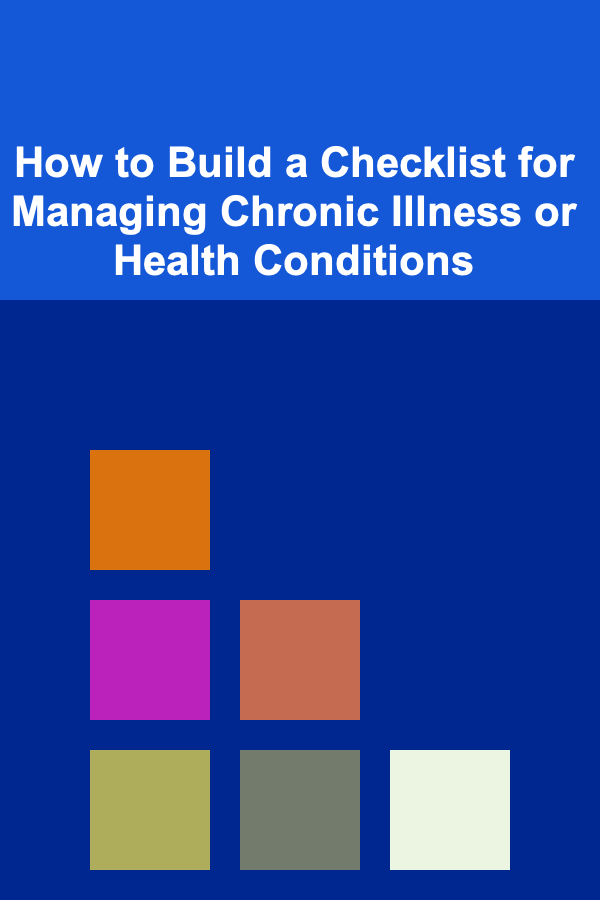
How to Track Medical Expenses for Family Members
ebook include PDF & Audio bundle (Micro Guide)
$12.99$11.99
Limited Time Offer! Order within the next:
Not available at this time

Tracking medical expenses is an essential practice for individuals managing family finances. Whether you're navigating insurance claims, budgeting for out-of-pocket costs, or ensuring you're maximizing tax deductions, understanding how to track medical expenses can help alleviate stress and prevent surprises. For families, where medical expenses can quickly add up, it's crucial to develop an organized system to manage both expected and unexpected health-related costs. This guide outlines the steps and tools you can use to track medical expenses effectively for your family members.
Why Track Medical Expenses?
Tracking medical expenses allows you to:
- Ensure Accurate Insurance Claims: By keeping a record of all medical costs, you can verify that claims are processed correctly, and any discrepancies can be addressed promptly.
- Manage Family Budgeting: Medical costs can be significant, and understanding where the money goes helps you plan better for future expenses.
- Maximize Tax Deductions: For those eligible, tracking medical expenses can help you claim deductions on your tax returns, especially if your expenses exceed a certain threshold.
- Improve Health Financial Planning: Tracking allows you to anticipate upcoming costs, such as medications, therapies, or surgeries, ensuring that you allocate funds appropriately.
What to Track
To track your medical expenses efficiently, it's crucial to know what kinds of expenses you need to monitor. Here's a breakdown:
1. Insurance Premiums and Contributions
- Monthly health insurance premiums for the family.
- Any additional health insurance or supplementary policies such as dental, vision, or life insurance premiums.
2. Out-of-Pocket Medical Expenses
- Doctor's Visits: Charges for consultations with primary care physicians, specialists, or other healthcare providers.
- Diagnostic Tests: Expenses for lab tests, imaging (X-rays, MRIs), or screenings.
- Prescriptions: Costs of prescribed medications, over-the-counter drugs, and any necessary refills.
- Emergency Care: Hospital visits, emergency room charges, or ambulance services.
- Hospital Stays: Inpatient care charges for surgeries, treatments, or long-term care.
- Medical Equipment and Supplies: Costs for things like crutches, wheelchairs, home care equipment, or prosthetics.
3. Transportation and Travel Costs
- Travel expenses to and from medical appointments (gas, public transportation, parking fees).
- Accommodations for family members traveling for specialized care or treatments, especially for long-distance hospital stays.
4. Alternative Therapies and Wellness Programs
- Payments for treatments such as acupuncture, chiropractic care, physiotherapy, or other holistic healthcare options.
- Wellness programs like smoking cessation or weight loss programs that may be medically prescribed.
5. Long-Term Care Costs
- Costs related to elderly care or special medical needs, including nursing homes, assisted living, or in-home care services.
- Costs for managing chronic conditions that require regular visits or treatments (e.g., diabetes, heart disease).
How to Track Medical Expenses
Now that you know what to track, here are the methods you can use to keep an organized and effective record of your medical expenses.
1. Create a Medical Expense Log
A simple yet effective way to track medical expenses is to maintain a medical expense log. You can use a notebook, spreadsheet, or specialized app to log the details of each expense as it occurs.
What to Include in Your Log:
- Date: When the service was provided or the expense was incurred.
- Provider: Name of the doctor, hospital, pharmacy, or healthcare provider.
- Description: A brief description of the service (e.g., consultation, test, medication).
- Amount: The cost of the service or item.
- Insurance Reimbursement: Any amounts reimbursed by insurance, if applicable.
- Out-of-Pocket Cost: The remaining amount after insurance reimbursement (if applicable).
- Payment Method: Whether the expense was paid through credit card, insurance, or cash.
Keeping track in this way provides a detailed log that is easy to review when preparing taxes or checking for insurance discrepancies.
2. Use Spreadsheets
A more organized and customizable way to track medical expenses is by using a spreadsheet program like Microsoft Excel or Google Sheets. With a spreadsheet, you can create categories, track totals, and even use formulas to calculate annual totals.
Benefits of Using a Spreadsheet:
- You can create customized categories (e.g., doctor visits, prescriptions, transportation, etc.).
- Excel or Google Sheets can calculate totals, allowing you to quickly see how much you've spent.
- You can attach receipts or invoices digitally for easier reference.
Example Layout for a Medical Expenses Spreadsheet:
| Date | Provider | Service | Amount | Insurance Paid | Out-of-Pocket | Notes | |------------|---------------|--------------|--------|----------------|---------------|---------------------------| | 2025-06-01 | Dr. Smith | Consultation | $100 | $80 | $20 | General checkup | | 2025-06-05 | Walgreens | Prescription | $15 | $0 | $15 | Blood pressure medication | | 2025-06-10 | City Hospital | X-Ray | $250 | $150 | $100 | Follow-up exam |
The above spreadsheet format gives a clear picture of what's being paid, what's reimbursed, and what is your responsibility.
3. Expense Tracker Apps
There are a variety of apps designed specifically to help you track medical expenses. These apps can simplify the process by automatically categorizing expenses, storing receipts, and syncing with your bank or credit card statements.
Popular Medical Expense Tracker Apps:
- Mint: While not specifically for medical expenses, Mint can track healthcare spending alongside other expenses.
- Expensify: This app lets you scan and store receipts and is ideal for people who make frequent out-of-pocket purchases.
- MedBill: A medical expense tracker app designed to help families track medical costs, insurance claims, and out-of-pocket expenses.
These apps can save time and help you stay on top of your medical spending with minimal effort.
4. Use Insurance Statements
Insurance providers send periodic statements detailing what costs they have covered and what expenses you still need to pay. These statements can be useful to track your out-of-pocket expenses and ensure that your insurance is reimbursing you correctly.
Steps to Use Insurance Statements:
- Keep track of EOBs (Explanation of Benefits) from your insurance company.
- Compare the costs listed on the EOB with what you were charged to ensure the insurance has covered the right amount.
- Use the insurance statements as a reference to keep your own records up-to-date and spot any discrepancies early.
5. Keep Receipts and Documentation
Receipts from pharmacies, clinics, and hospitals can often provide additional detail that's necessary for filing taxes or verifying medical expenses. Always ask for a receipt when you pay for any medical service or medication.
Organizing Receipts:
- Store physical receipts in a designated folder or envelope.
- For digital receipts, scan or photograph them and store them in a cloud service or dedicated folder on your phone or computer.
- For convenience, make a habit of storing receipts for up to a year (or longer if required for tax purposes).
6. Set a Medical Budget
As part of your overall family budget, it's important to set aside a certain amount each month for medical expenses. This can help you anticipate upcoming medical costs and manage both expected and unexpected bills.
Benefits of Setting a Budget:
- Helps avoid surprises and manage out-of-pocket expenses.
- Enables you to prioritize medical services based on your family's needs.
- Allows you to plan ahead for upcoming medical procedures or treatments that may require a significant out-of-pocket cost.
7. Track Medical Expenses for Tax Deductions
In the United States, medical expenses that exceed a certain percentage of your income can be deducted from your taxable income. Keeping detailed records of all medical expenses is essential to maximizing your tax deductions.
Key Points:
- In the U.S., medical expenses that exceed 7.5% of your adjusted gross income (AGI) may be deductible (as of 2023).
- Keep receipts, statements, and other documentation of expenses for the entire year.
- Consult with a tax professional to ensure you're taking full advantage of any deductions.
Conclusion
Tracking medical expenses for your family is a necessary part of managing healthcare costs, especially as these costs can accumulate over time. Whether you prefer using paper logs, spreadsheets, apps, or insurance statements, it's important to stay organized and proactive about your health finances. By following the tips and tools outlined in this guide, you'll be better equipped to manage medical expenses efficiently, ensure that you're not overpaying, and maximize your potential for tax savings.
The key to successful tracking is consistency. Make it a habit to track your expenses as they occur, and periodically review your records to stay on top of your health spending. With a little organization and diligence, tracking medical expenses can become a manageable and rewarding task.

How to Build a Checklist for Managing Chronic Illness or Health Conditions
Read More
How to Generate Recurring Income Using AI and Deep Learning
Read More
How to Use Art and Accessories to Elevate Your Home Staging
Read More
How to Use Dimmer Switches to Control Ambiance
Read More
How to Pick the Perfect Dark Comedy Series
Read More
How to Grasp the Concepts of Sharding in Blockchain
Read MoreOther Products

How to Build a Checklist for Managing Chronic Illness or Health Conditions
Read More
How to Generate Recurring Income Using AI and Deep Learning
Read More
How to Use Art and Accessories to Elevate Your Home Staging
Read More
How to Use Dimmer Switches to Control Ambiance
Read More
How to Pick the Perfect Dark Comedy Series
Read More